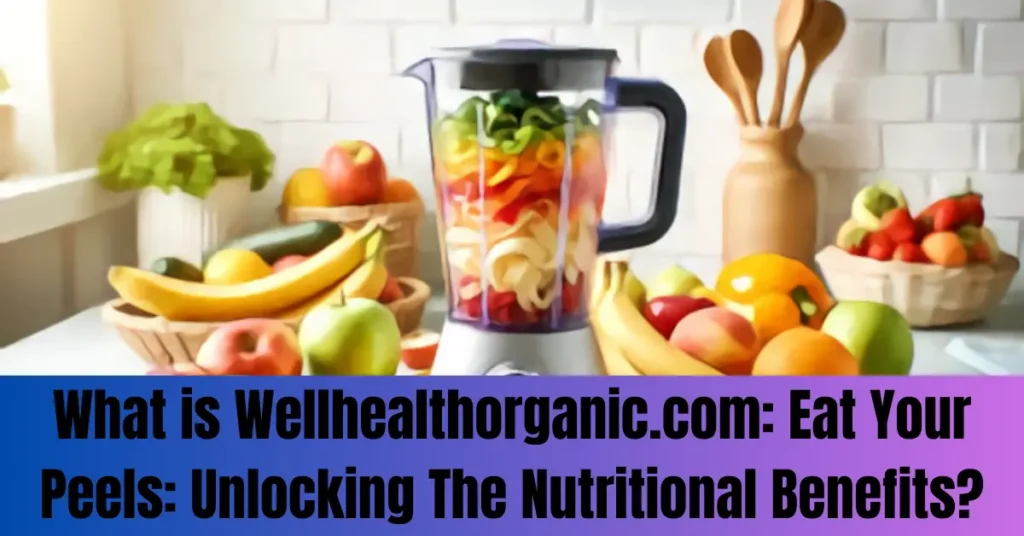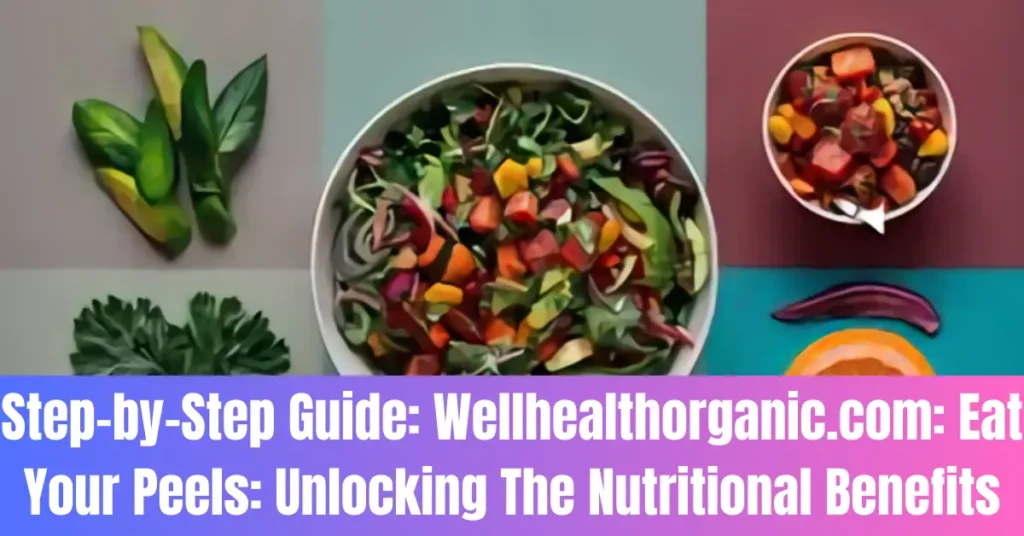Introduction:
Welcome to our blog on Wellhealthorganic.com:Eat Your Peels: Unlocking The Nutritional Benefits! Today, we’re diving into a topic that might surprise you—eating fruit and vegetable peels. It might seem unusual, but these peels are packed with nutrients and benefits that you don’t want to miss out on. From boosting your health to adding flavor and texture to your meals, peels can be a fantastic addition to your diet.
In this article, we’ll explore the many ways eating peels can enhance your nutrition and why you should consider incorporating them into your daily routine. Let’s unlock the nutritional benefits of those often-overlooked peels together!
What is Wellhealthorganic.com: Eat Your Peels: Unlocking The Nutritional Benefits?

- Wellhealthorganic.com: Eat Your Peels: Unlocking The Nutritional Benefits is an insightful guide dedicated to revealing the hidden advantages of eating fruit and vegetable peels.
- This resource emphasizes the often-overlooked peels of common produce items, showcasing how they can enhance your health and nutrition.
- The guide delves into the nutritional value that peels bring to the table, such as vitamins, minerals, and fiber that are typically concentrated in these outer layers.
- It also offers practical tips on how to incorporate peels into your diet, whether through recipes, cooking techniques, or simple snack ideas.
- By highlighting the benefits of consuming peels, Wellhealthorganic.com encourages a more sustainable and health-conscious approach to eating, helping you make the most out of your fruits and vegetables.
You May Also Like It
Instagram Par Follower Kaise Badhaye With Can Follow Website – Veganov Trichy
1000+ Free Instagram Story Views In 2024 – Veganov Trichy
How To Increase Followers On Instagram With TakipciGir New Update 2024
Why is Wellhealthorganic.com: Eat Your Peels: Unlocking The Nutritional Benefits Important?
Understanding the importance of eating peels is key to maximizing the health benefits of your diet. Here’s why this concept is so valuable:
Nutritional Powerhouse
- Rich in Vitamins and Minerals: Many peels are loaded with essential nutrients. For example, apple peels contain fiber, vitamin C, and antioxidants.
- High in Fiber: Peels often have higher fiber content compared to the flesh, aiding in digestion and promoting a feeling of fullness.
- Antioxidant Benefits: Peels can be rich in antioxidants, which help fight free radicals and reduce inflammation in the body.
Sustainability and Waste Reduction
- Minimizes Food Waste: Utilizing peels helps reduce food waste by making use of parts that are often discarded.
- Eco-Friendly: Eating peels contributes to a more sustainable lifestyle by lowering the environmental impact associated with food disposal.
Cost-Effective
- Reduces Grocery Bills: Using peels in your cooking can save money, as it allows you to make the most of the produce you buy.
- Enhances Food Value: Peels can add flavor, texture, and nutritional value to dishes, making them a versatile addition to your kitchen.
Improves Culinary Variety
- Adds Flavor and Texture: Peels can provide unique flavors and textures that enhance the overall taste of your meals.
- Creative Cooking Opportunities: Incorporating peels opens up new culinary possibilities and encourages experimenting with recipes.
Promotes Healthy Eating Habits
- Encourages Mindful Eating: Paying attention to peels encourages a more thoughtful approach to your diet.
- Increases Nutrient Intake: By consuming peels, you’re more likely to get a wider range of nutrients from your fruits and vegetables.
Step-by-Step Guide: Wellhealthorganic.com: Eat Your Peels: Unlocking The Nutritional Benefits

Choose the Right Produce
- Select Organic When Possible: Organic fruits and vegetables are less likely to be coated with pesticides, making their peels safer to eat.
- Opt for Fresh Produce: Choose firm, fresh fruits and vegetables. Avoid those with blemishes or signs of spoilage.
Clean Thoroughly
- Wash Peels Properly: Rinse fruits and vegetables under running water to remove dirt and bacteria. Use a brush for harder peels like potatoes.
- Consider Peeling: For produce that might have been treated with chemicals, consider peeling but use the peels in recipes where possible.
Incorporate Peels into Your Meals
- Add to Smoothies: Blend fruit peels, like apple or cucumber, into smoothies for added fiber and nutrients.
- Use in Salads: Shred or slice peels, such as carrot or beet peels, and add them to salads for extra crunch and nutrition.
- Incorporate into Soups and Stews: Add peels like potato or squash to soups and stews. They cook down and can enhance the flavor and nutritional profile.
Get Creative with Cooking
- Make Chips: Try making vegetable peels into crispy chips. For example, bake potato or sweet potato peels with a bit of olive oil and seasoning.
- Create Garnishes: Use citrus peels, like lemon or lime, as zest or garnish to add flavor and visual appeal to dishes.
- Infuse Water: Add fruit peels to water or herbal teas for a refreshing twist and added nutrients.
Store Peels Properly
- Refrigerate for Freshness: Store peels in an airtight container in the refrigerator to keep them fresh.
- Freeze for Later Use: If you have excess peels, freeze them for later use in smoothies, soups, or baking.
Experiment and Learn
- Try New Recipes: Explore recipes that specifically use peels, such as peel-based jams or pickles.
- Observe and Adjust: Pay attention to how different peels affect the taste and texture of your dishes. Adjust cooking times and methods as needed.
Educate Yourself
- Read Up on Benefits: Stay informed about the nutritional benefits of various peels and how they contribute to your overall health.
- Share Knowledge: Spread the word about the benefits of eating peels and encourage others to try incorporating them into their diets.
Advantages
Nutritional Benefits
- Rich in Nutrients: Peels often contain higher concentrations of vitamins, minerals, and antioxidants compared to the flesh of fruits and vegetables.
- Increased Fiber: Many peels are high in dietary fiber, which supports digestive health and helps maintain a feeling of fullness.
Sustainability
- Reduces Food Waste: Utilizing peels helps minimize food waste by making use of parts of produce that would otherwise be discarded.
- Eco-Friendly: Eating peels contributes to a more sustainable lifestyle by reducing the environmental impact associated with food disposal.
Cost-Effectiveness
- Saves Money: Making use of peels can help reduce grocery bills by maximizing the use of the produce you purchase.
- Enhances Value: Peels add additional flavor and texture to dishes, enhancing the overall value and enjoyment of your meals.
Culinary Creativity
- Versatile Ingredient: Peels can be used in a variety of recipes, from smoothies to soups, offering new ways to enjoy fruits and vegetables.
- Unique Flavors: Incorporating peels can introduce unique flavors and textures to your cooking.
Health Benefits
- Antioxidant Properties: Many peels are rich in antioxidants, which can help combat oxidative stress and reduce inflammation.
- Supports Immune Health: Some peels, like citrus peels, contain compounds that can support immune function.
Disadvantages
Pesticide Residues
- Chemical Exposure: Non-organic peels may have pesticide residues that could pose health risks. Washing thoroughly can help, but some people prefer to avoid peels for this reason.
Digestive Issues
- Potential Irritation: Some peels, particularly those high in fiber, may cause digestive discomfort or irritation in sensitive individuals.
Taste and Texture
- Unpleasant Flavor: Not all peels have pleasant flavors or textures. Some may be too bitter or tough to enjoy.
- Preparation Time: Preparing peels for consumption might require additional steps, such as peeling, washing, or cooking, which can be time-consuming.
Food Safety
- Spoilage Risks: Peels can spoil quickly if not stored properly, leading to potential food safety concerns.
- Cross-Contamination: There’s a risk of cross-contamination if peels are not handled or stored correctly, especially if using them raw.
Limited Use
- Not Always Suitable: Some peels may not be suitable for all recipes or may not blend well with other ingredients, limiting their versatility.
Can I eat the peels of all fruits and vegetables?
Most peels are edible, but some are more palatable and nutritious than others. Common peels like apple, carrot, and cucumber are great to eat, while others, like certain citrus peels, might need to be prepared differently. Always check if the peel is safe and enjoyable to eat.
How should I clean peels before eating them?
Wash fruits and vegetables thoroughly under running water to remove dirt and bacteria. Use a brush for harder peels, like potatoes. For non-organic produce, consider peeling if you’re concerned about pesticide residues.
Are organic peels safer to eat?
Yes, organic produce is less likely to be treated with harmful pesticides, making its peels generally safer to eat. However, it’s still important to wash them well before consuming.
What are the health benefits of eating peels?
Peels are often rich in fiber, vitamins, and antioxidants. They can help with digestion, provide essential nutrients, and offer antioxidant benefits that support overall health.
Can eating peels cause digestive problems?
For some people, peels may cause digestive discomfort, especially if they are high in fiber. If you’re sensitive to fiber or have a digestive condition, start with small amounts and see how your body reacts.
How can I use peels in my cooking?
Peels can be added to smoothies, salads, soups, and stews. You can also make chips from vegetable peels or use citrus peels as zest or garnishes. Get creative with how you include peels in your meals!
Conclusion
Eating peels can be a fantastic way to boost your nutrition and reduce food waste. By incorporating peels from fruits and vegetables into your diet, you can enjoy extra fiber, vitamins, and antioxidants while adding new flavors and textures to your meals.
Just remember to wash them thoroughly and choose organic when possible to avoid pesticides. So next time you’re about to toss those peels, think again—they might just be the nutritional boost your diet needs!
Bonus Points: Wellhealthorganic.com: Eat Your Peels: Unlocking The Nutritional Benefits
Use Peels for Homemade Cleaning Solutions
- Citrus peels, like lemon or orange, can be used to make natural cleaning solutions. Simply soak peels in vinegar to create a fresh, eco-friendly cleaner.
Create Flavored Water
- Infuse water with fruit peels like cucumber or lemon for a refreshing, nutrient-packed drink. It’s a great way to stay hydrated and add extra nutrients to your daily intake.
Grow Your Own
- Save peels from certain fruits and vegetables to grow new plants. For example, potato peels can sometimes be used to grow new potatoes, and citrus peels can be composted to enrich garden soil.
Add Peels to Homemade Stocks
- Use vegetable peels in homemade stocks and broths to add depth of flavor and nutrition. They can enhance the taste while providing extra vitamins and minerals.
Make Homemade Potpourri
- Dried citrus peels or apple peels can be used to create fragrant potpourri. It’s a great way to recycle peels and enjoy their natural scents around your home.
Incorporate Peels in Natural Beauty Remedies
- Citrus peels can be used in DIY face masks or scrubs due to their natural exfoliating properties and vitamin C content. Just ensure they are finely ground or used in small quantities to avoid skin irritation.
Preserve Peels
- Experiment with preserving peels by making jams, pickles, or candied peels. This not only extends their shelf life but also adds a unique twist to your culinary creations.
You May Also Like It
Trendzguruji.me – Computer, Cyber, Awareness, SEO, Health & Beauty Guide
TrendzGuruji.me Cyber Insights Hub
“What’s Up with Emerald Gems? Let’s Talk”
